สมาร์ทแพคเกจจิ้ง (Smart Packaging) สามารถเชื่อมโยงโลกจริงกับโลกดิจิทัลได้สร้างสะพานดิจิทัลที่สมบูรณ์แบบระหว่างผู้ผลิต ผู้ค้าปลีก ผู้บริโภค และช่องทางโซเชียลมีเดีย แล้วสมาร์ทแพคเกจจิ้ง คืออะไรกันแน่ โดยหลักการแล้ว สมาร์ทแพคเกจจิ้หมายถึงบรรจุภัณฑ์ที่มีหน้าที่หน้าที่พิเศษเสริมเข้าไป โดยทั่วไป บรรจุภัณฑ์อัจฉริยะมีสองประเภท คือ บรรจุภัณฑ์แบบแอคทีฟ และ บรรจุภัณฑ์อัจฉริยะ บรรจุภัณฑ์แบบแอคทีฟสามารถสร้างการเปลี่ยนแปลงให้กับตัวสินค้าและช่วยปรับปรุงอายุหรือคุณภาพของสินค้าในคลังสินค้า โดยใช้วัสดุกรองแสง ตัวดูดซับออกซิเจนและเอทิลีน การเคลือบพื้นผิวต้านจุลชีพ หรือ วัสดุควบคุมความชื้น ตัวอย่างเช่น ขวดเบียร์พลาสติกที่มีตัวดูดซับออกซิเจนอยู่ในฝาเกลียว จะช่วยยืดอายุของเบียร์ได้สามถึงหกเดือน
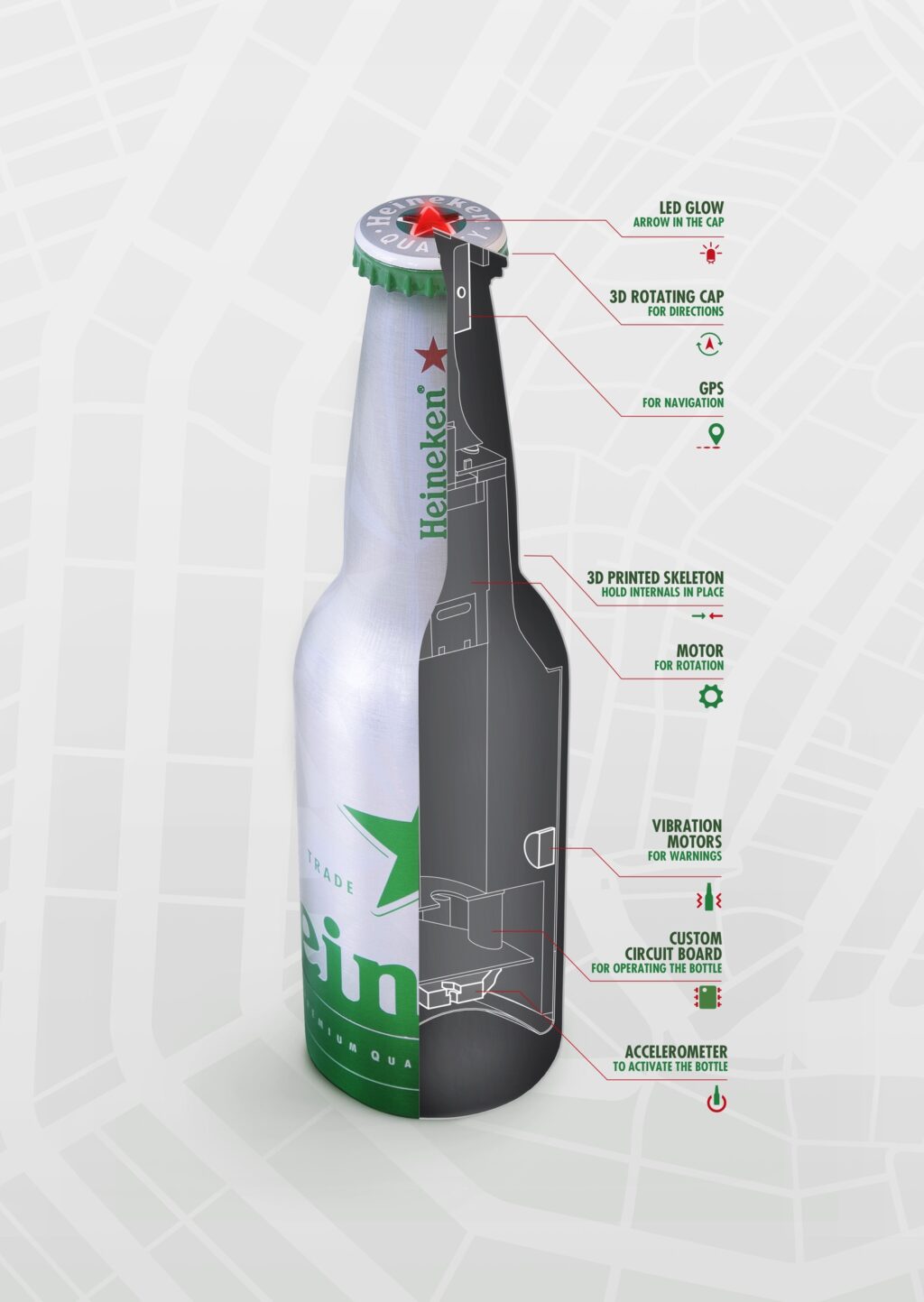
Credits: Agency: J. Walter Thompson Amsterdam; Creative Directors: Bas Korsten / Ferran López; Creatives: Mark Peeters, Robert Nelk, Guney Soykan; Creative Technologist: Emmanuel Flores
บรรจุภัณฑ์อัจฉริยะมีประโยน์นอกเหนือการเป็นบรรจุภัณฑ์เพียงอย่างเดียว ความชาญฉลาดของบรรจุภัณฑ์เป็นผลมาจากการสื่อสารกับโลกภายนอก เช่น ความสามารถในการวินิจฉัยและตรวจสอบคุณภาพของผลิตภัณฑ์โดยใช้เซ็นเซอร์และอุปกรณ์บ่งชี้ต่าง ๆ ทำให้ทราบข้อมูล เช่น ความแน่น เวลาในการเก็บรักษา อุณหภูมิ หรือความสด ทั้งนี้ ตัวบ่งชี้หรือเซ็นเซอร์สามารถวางไว้ด้านนอกหรือด้านในบรรจุภัณฑ์ก็ได้ บรรจุภัณฑ์อัจฉริยะยังสนับสนุนความต้องการของ การประมวลผลทางสารสนเทศ ระบบอัตโนมัติ การตลาด หรือการปกป้องตัวสินค้า ผ่านเทคโนโลยี เช่น บาร์โค้ด, ไฟ LED, เทคโนโลยีความจริงเสริม, NFC, ลำโพง, ชิปวิทยุ หรือจอแสดงผล ตัวอย่าง เช่น บรรจุภัณฑ์ยาอัจฉริยะที่มีชิป RFID ในตัว ไฟ LED และลำโพงขนาดเล็กที่บันทึกการนำเม็ดยาออกและส่งเสียงเตือนหากหยิบยาไม่ถูกต้อง หรือแม้แต่แจ้งให้แพทย์ที่ทำการรักษาผู้ป่วยทราบ เช่นเดียวกับบรรจุภัณฑ์ที่มีชิป NFC ซึ่งใช้ตัวอ่าน NFC (เช่น สมาร์ทโฟน) ที่อ่านฉลากในบรรจุภัณฑ์และสั่งซื้อยาใหม่ได้
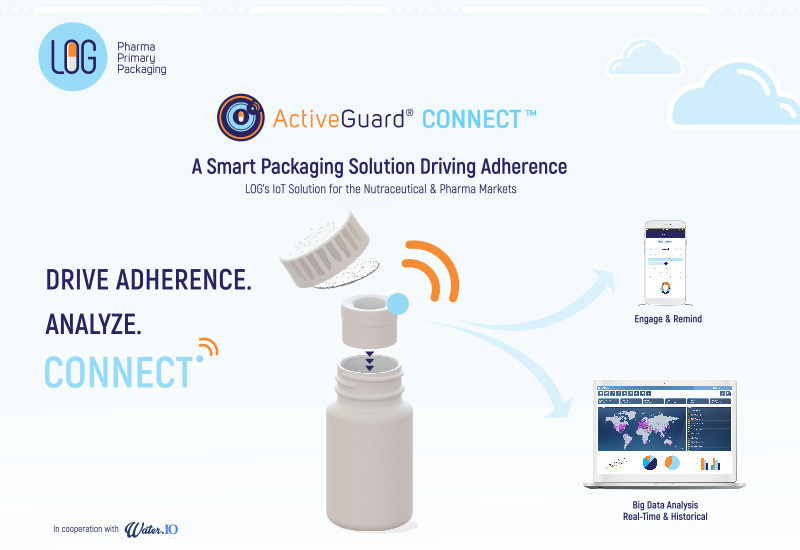
บรรจุภัณฑ์อัจฉริยะทำให้ผู้ใช้สมาร์ทโฟนได้รับข้อมูลเพิ่มเติมเกี่ยวกับ แหล่งกำเนิดของสินค้า เงื่อนไขการผลิต หรือส่วนผสม โดยสแกนบาร์โค้ดหรือชิป RFID ร่วมกับแอพที่มีอยู่ผ่านอินเทอร์เน็ต ในขณะเดียวกัน เทคโนโลยีนี้ยังนำไปใช้ในงานโลจิสติกส์และการตลาดอีกด้วย เช่น จอห์นนี่ วอล์กเกอร์ บลู เลเบิ้ล ใช้เซ็นเซอร์อิเล็กทรอนิกส์ที่บางมากซึ่งจะส่งสัญญาณเมื่อมีการเปิดขวดหรือส่งข้อมูลตำแหน่งว่าอยู่ ณ ที่ใดในห่วงโซ่การกระจายสินค้า นอกจากนี้ บริษัท Diageo ยังสามารถอัพโหลดรายการส่งเสริมการขายไปยังสินค้าแต่ละขวด ทันทีที่เซ็นเซอร์ระบุว่าขวดถูกเปิดแล้ว ข้อมูลตำแหน่งจะถูกส่งไปยังผู้ผลิต
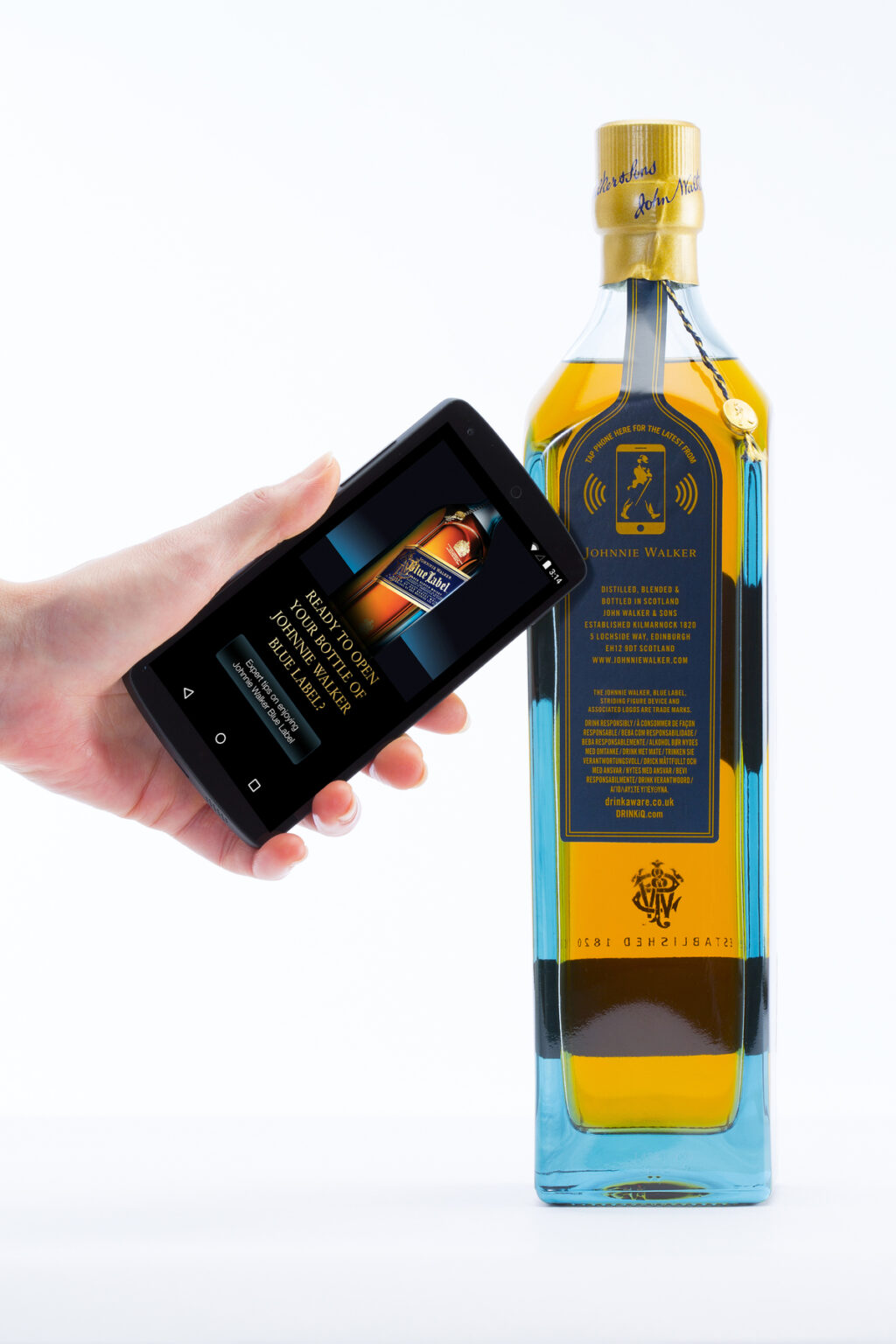
Credits: Diageo, a multinational alcoholic beverages company, and Thin Film Electronics, a Norwegian printed electronics company
จากวิจัยการตลาดของ Maximize ตลาดสมาร์ทแพคเกจจิ้งมีมูลค่า 39.68 พันล้านเหรียญสหรัฐในปี 2022 และคาดว่ารายได้รวมจะเติบโตถึง 4.56% ตั้งแต่ปี 2023 ถึง 2029 ซึ่งสูงถึงเกือบ 54.23 พันล้านเหรียญสหรัฐ ตัวขับเคลื่อนการเติบโตของตลาด ได้แก่ การเปลี่ยนแปลงทางประชากร ความต้องการอาหารแปรรูป ความจำเป็นในการยืดอายุการเก็บรักษาของผลิตภัณฑ์บรรจุภัณฑ์ การใส่ใจต่อความปลอดภัยของอาหาร การตระหนักรู้ด้านสุขภาพที่เพิ่มขึ้น และการจัดการห่วงโซ่อุปทานที่ดีขึ้น การเติบโตของตลาดเกิดจากวิถีชีวิตที่เปลี่ยนไปอันเป็นผลจากการขยายตัวของชุมชนเมือง โดยเฉพาะอย่างยิ่งในประเทศเศรษฐกิจเกิดใหม่
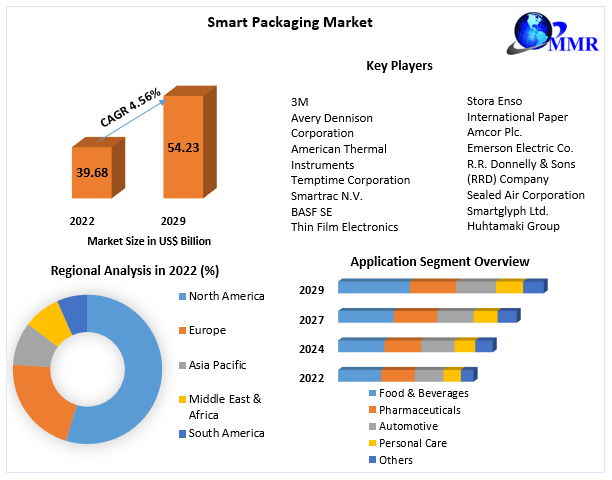
Credits: Smart Packaging Market: Global Industry Analysis and Forecast (2023-2029) by Maximize Market Research (MMR)
บรรจุภัณฑ์ดัดแปลงบรรยากาศมีส่วนแบ่งการตลาดสูงสุดในปี 2022 ความต้องการที่เพิ่มขึ้นสำหรับสินค้าอาหารบรรจุภัณฑ์ที่สดใหม่และมีคุณภาพสูง เช่น ขนมปัง ผลไม้และผัก เนื้อสัตว์แปรรูป ปลา อาหารทะเล และผลิตภัณฑ์จากนม เป็นปัจจัยหลักที่ส่งผลต่อส่วนการตลาดที่สูงขึ้น วิถีชีวิตที่เร่งรีบทำให้ การเปลี่ยนไปใช้บรรจุภัณฑ์ที่หยิบจับได้ง่ายและสะดวก และเศรษฐกิจที่กำลังเติบโต ล้วนส่งผลต่อความต้องการบรรจุภัณฑ์ดัดแปลงบรรยากาศ ในทางกลับกัน คาดว่าบรรจุภัณฑ์อัจฉริยะจะเติบโตในอัตราที่เร็วที่สุดในช่วงระยะเวลาคาดการณ์ โดยกลุ่มเภสัชกรรมคาดว่าจะมี CAGR สูงสุดในช่วงที่คาดการณ์ไว้ การบูรณาการณ์เทคโนโลยีบาร์โค้ด, RFID และเทคโนโลยีเซ็นเซอร์ นำไปใช้ประโยชน์ในธุรกิจยาเพื่อตรวจสอบข้อมูล เช่น วันหมดอายุของยา การบริโภค และขนาดยา ตลอดจนนวัตกรรมในธุรกิจเภสัชกรรม ต่างทำให้กลุ่มเภสัชกรรมเติบโตอย่างมาก อย่างไรก็ตาม ในปี 2022 กลุ่มอาหารและเครื่องดื่มยังถือครองตลาดส่วนใหญ่
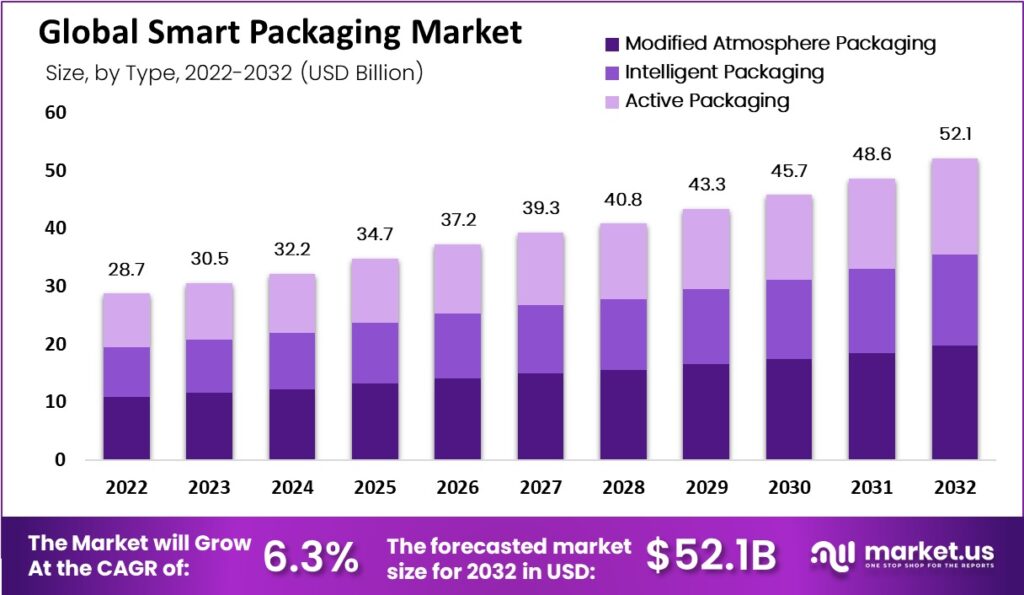
Credits: Global Smart Packaging Market By Type (Active Packaging, Intelligent Packaging, and Modified Atmosphere Packaging), By Material Type, By End-User, By Region and Companies – Industry Segment Outlook, Market Assessment, Competition Scenario, Trends, and Forecast 2023-2032 by Market.Us
จากการวิจัยของ Market.Us ตลาดบรรจุภัณฑ์อัจฉริยะถูกครอบงำโดยเอเชียแปซิฟิก ซึ่งได้รับส่วนแบ่งรายได้ที่สำคัญที่สุดที่ 33% ในปี 2565 การปรากฏตัวของผู้เล่นหลักในภูมิภาคเอเชียแปซิฟิก เช่น Ester Industries LTD และ TCPL Packaging LTD กำลังขับเคลื่อนการเติบโตของตลาด การเติบโตของตลาดในภูมิภาคเอเชียแปซิฟิกขับเคลื่อนโดยความต้องการที่เพิ่มขึ้นจากอุตสาหกรรมการผลิตในประเทศเศรษฐกิจเกิดใหม่ เช่น จีน ญี่ปุ่น และอินเดีย นอกจากนี้ การใช้งานสมาร์ทโฟนที่เพิ่มขึ้นและการเกิดขึ้นของช่องทางการช็อปปิ้งออนไลน์ทำให้เกิดความต้องการบรรจุภัณฑ์อัจฉริยะในอุตสาหกรรมอีคอมเมิร์ซ อย่างไรก็ตาม จากข้อมูลของ Mordor Intelligence อเมริกาเหนือคาดว่าจะมีส่วนแบ่งการตลาดที่สำคัญ เนื่องจากกฎระเบียบที่เอื้ออำนวย การมุ่งเน้นที่ความยั่งยืน และความต้องการที่เพิ่มขึ้นสำหรับบรรจุภัณฑ์อัจฉริยะและแอคทีฟในกลุ่มผู้ใช้ปลายทางต่างๆ โดยเฉพาะอุตสาหกรรมอาหารและการดูแลสุขภาพ ตลาดบรรจุภัณฑ์อัจฉริยะในสหรัฐอเมริกามีการเติบโตอย่างมากในช่วงไม่กี่ปีที่ผ่านมา
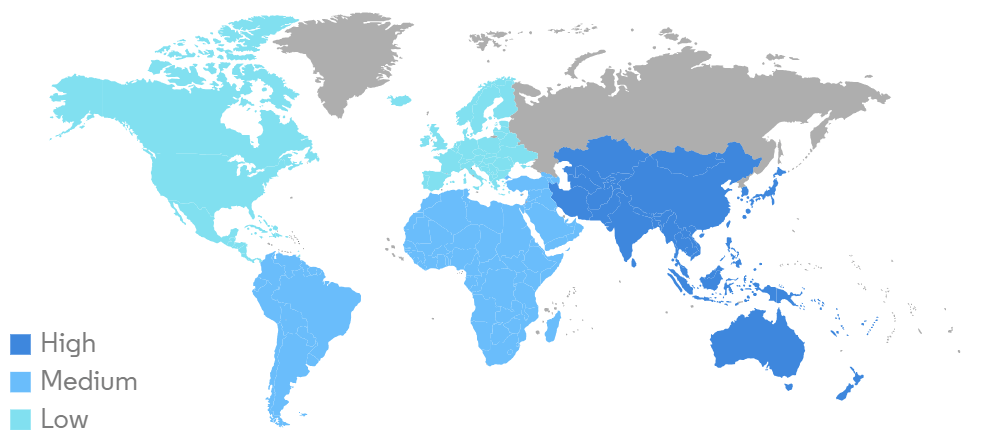
Credits: Smart Packaging Market Size & Share Analysis – Growth Trends & Forecasts (2023 – 2028) by Mordor Intelligence
Article by: Asst. Prof. Suwan Juntiwasarakij, Ph.D., Senior Editor & MEGA Tech












